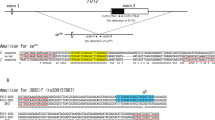Summary
Among 39 members of a family (“FES”) 11 were found to have the rare C3 variant F0.65. In sera of 4 of 9 members in a second family (“Wt”) the rare C3 variant F0.5 could be detected. Variant-typing was performed on enlarged photographs of electrophoretic runs in which 5 known rare variants were used as reference sera. Typing was carried out by graphic means with a deviation of ±0.036 relative variant units. The F0.65 variant could be observed to follow autosomal codominant inheritance whereas in the F0.5 variant family 1 member possessed the variant which could not be demonstrated in his parents. Quantitation of C3c seems to exclude the occurrence of a Co gene, nor was there evidence for a hypomorphic f. As a possible reason unsatisfactory separation of the F and F0.5 band is discussed. Buffers without calcium ions and runs up to 9 hrs did not improve electrophoretic separation to an extend that 2 bands could be seen. Pt-typing was also performed but did not elucidate the problem. In both families parentage was confirmed through biostatistical evaluation of 17 additional genetic markers.
Zusammenfassung
11 Angehörige von insgesamt 39 untersuchten Mitgliedern einer Sippe (“FES”) zeigten eine schnelle F-Variante, welche als F0.65 bestimmt wurde. Von insgesamt 9 untersuchten Mitgliedern einer weiteren Sippe (“Wt”) fand sich bei 4 Angehörigen eine schnelle F-Variante, welche als F0.5 bestimmt wurde. Die zur Typisierung erforderlichen Ausmessungen wurden an fotografischen Vergrößerungen vorgenommen. Als Referenzseren dienten 5 bekannte Variantenseren. Die Ermittlung des Variantentyps erfolgte auf graphischem Wege mit einer Genauigkeit von±0,036 Einheiten. Die Variante der Familie “FES” zeigte kodominanten (kombinanten) Erbgang. In der Familie “Wt” war bei einer Person die Variante F0.5 festzustellen, obwohl deren Eltern die Eigenschaft nicht besaßen. Da eine Suppression auf Grund quantitativer Bestimmung von C3c praktisch ausscheidet, ist die Ursache der “Erbabweichung” in einer ungenügenden Auftrennung der Proteine F und F0.5 in der Elektrophorese zu suchen. Auch mit calciumionenfreiem Puffer und über 9 Std hinaus verlängerter Phoresezeit war eine Trennung nicht zu erreichen. Neben den C3-Untersuchungen wurde eine Pt-Typisierung durchgeführt. Die Genprodukte F,F0.65 und F0.5 stellten sich als Pt (A) dar, das Genprodukt S als Pt (B). Die Abstammungsverhältnisse in beiden Familien wurden durch biostatistische Auswertung von Blutgruppeneigenschaften gesichert.
Similar content being viewed by others
Literatur
Alper, C. A.: Genetics and the C3 molecule. Vox Sang. (Basel) 25, 1 (1973)
Alper, C. A., Propp, R. P.: Genetic polymorphism of the third component of human complement (C′3). J. clin. Invest. 47, 2181 (1968)
Alper, C. A., Propp, R. P., Klemperer, M. R., Rosen, F. R.: Inherited deficiency of the third component of human complement (C′3). J. clin. Invest. 48, 553 (1969)
Alper, C. A., Rosen, F. S.: Studies of a hypomorphic variant of human C3. J. clin. Invest. 50, 324 (1971)
Azen, E. A., Smithies, O., Hiller, O.: High-voltage starch-gel electrophoresis in the study of post-albumin proteins and C′3 (β1C-globulin) polymorphism. Biochem. Genet. 3, 215 (1969)
First International Symposium and workshop on the polymorphism of the third component of the human complement system. Vox Sang. (Basel) 25, 9 (1973)
Hummel, K.: Biostatistische Abstammungsbegutachtung mit Blutgruppenbefunden. Tabellenband II. Stuttgart: Fischer 1973
Hummel, K., Mittelstädt, W.: Technische Verbesserungen beim Nachweis der Pt-Typen. 4. Tagung der Gesellschaft für forensische Blutgruppenkunde, Trier 1972
Hummel, K., Mittelstädt, W.: Different methods for pretreating sera: modification in the electrophoresis of Pt types. Vox. Sang. (Basel) 25, 14 (1973)
Laurell, C. B.: Antigen-antibody crossed electrophoresis. Anal. biochem. 10, 358 (1965)
Laurell, C. B., Lundh, B.: Electrophoretic studies of the conversion products of serum β1C-globulin. Immunology 12, 313 (1967)
Mancini, G., Carbonara, A. O., Heremans, J. F.: Immunochemical quantitation of antigens by single radial immunodiffusion. Immunochemistry 2, 235 (1965)
Mauff, G., Potrafki, B. G., Freis, H., Pulverer, G.: Vergleichende Untersuchungen zum Polymorphismus des Posttransferrins (Pt) und der dritten Komponente des Humankomplements (C3). Humangenetik 21, 75–80 (1974)
Mittelstädt, W.: Versuche zur Verbesserung der Darstellungstechnik der Pt-Typen; Resultate mit der verbesserten Technik an 567 Seren. Dissertation, Freiburg 1973
Oepen, I., Hilgermann, R., Dellbrügge, K., Schneitler, H.: Erfahrungen bei einem Vergleich von C′3- und Pt-Polymorphismen. 4. Tagung der Gesellschaft für forensische Blutgruppenkunde, Trier 1972
Pflugshaupt, R., Scherz, R., Steinegger, L., Bütler, R.: Die Frequenz der C3-Polymorphismen in der schweizerischen Bevölkerung, sowie einige Bemerkungen über die Identifizierung seltener Phänotypen. 5. Internationale Tagung der Gesellschaft für forensische Blutgruppenkunde, Amsterdam 1973
Potrafki, B. G., Hellenbroich, H., Pulverer, G.: Polymorphismus der erythrozytären NADH-Diaphorase in der westdeutschen Bevölkerung. Humangenetik 15, 182 (1972)
Rittner, Ch., Rittner, B.: Qualitative and quantitative comparison of C3 variant sera during the Bonn workshop. Vox Sang. (Basel) 25, 21 (1973a)
Rittner, Ch., Rittner, B.: Report '73 of the C3 reference laboratory. 5. Internationale Tagung der Gesellschaft für forensische Blutgruppenkunde, Amsterdam 1973b
Rose, M., Geserick, G.: Ein neuer Serumproteinpolymorphismus: Pt. Erste Hinweise für eine genetische Steuerung. Acta biol. med. germ. 23, 351 (1969)
Teisberg, P.: High-voltage agarose gel electrophoresis in the study of C3 polymorphism. Vox Sang. (Basel) 19, 47 (1970)
Author information
Authors and Affiliations
Rights and permissions
About this article
Cite this article
Mauff, G., Freis, H., Potrafki, B.G. et al. Zur Problematik der Bestimmung seltener Varianten des C3-Polymorphismus. Hum Genet 22, 211–220 (1974). https://doi.org/10.1007/BF00284824
Received:
Issue Date:
DOI: https://doi.org/10.1007/BF00284824




